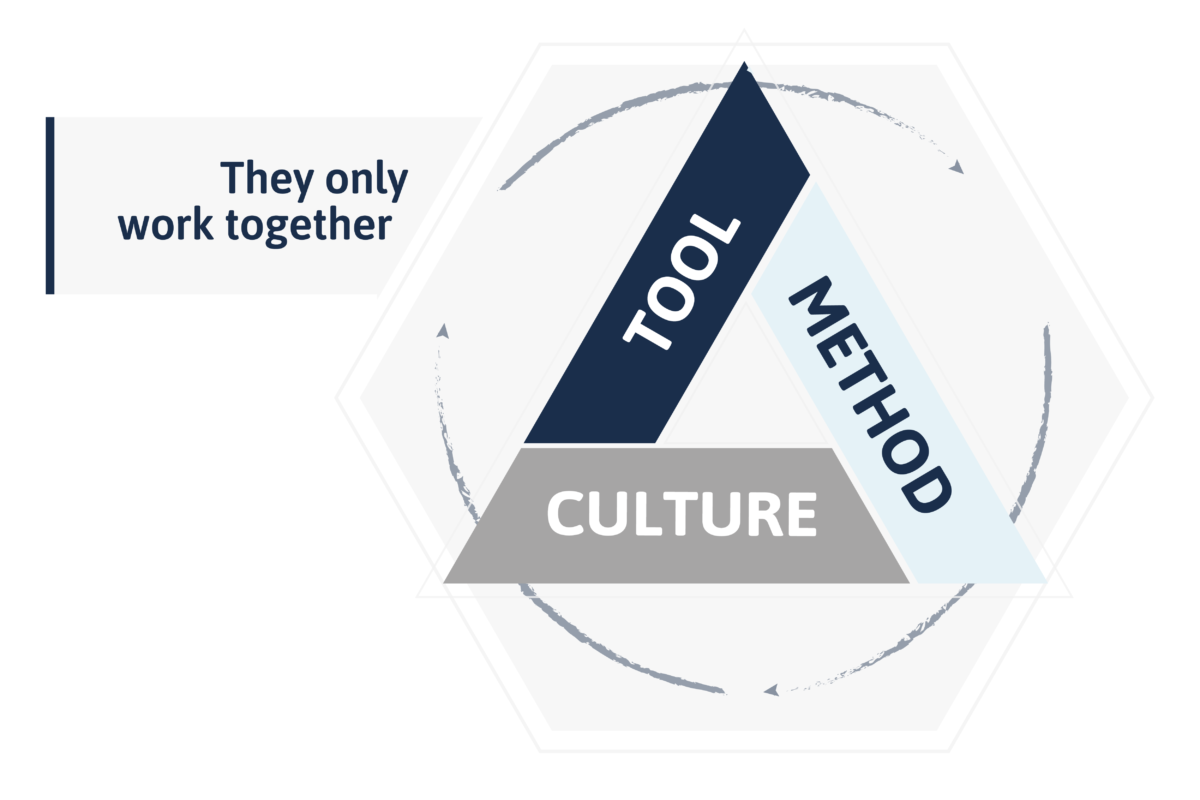Enterprise Architecture Management
Among other reasons due to the ever-changing business environments, technological developments and historically grown IT landscapes, Enterprise Architecture Management (EAM) is a discipline that is increasingly being used in companies of all sizes.
Enterprise Architecture Management (EAM) is an important part of any company’s strategy
EAM plays a critical role in achieving business goals and in implementing the corporate strategy. By creating a holistic overview of the organizational processes and the therefor used systems & technologies, optimization potentials can be identified by means of EAM.
Three Relevant Success Factors for Establishing Enterprise Architecture Management
We understand EAM as the interplay of tools, methods, and culture. These three areas are inseparably intertwined and form the central framework of digitalization along all levels of enterprise architecture.
Tool
For transparent and accessible documentation of architecture activities, the use of an EAM tool is recommended. Among other things, this should enable the modelling of all architecture levels (business, information, application & technology), a comprehensive repository, collaboration between different teams and the generation of reports suitable for management. There are already numerous off-the-shelf EAM tools on the market, such as LeanIX (EFS Consulting is a certified partner), Ardoq, ADOIT, etc.
Our approach
- Support of the tool rollout, definition of use cases for a sustainable use in day-to-day work and projects
- Technical, functional and procedural rollout
Method
The selection of the methodology or approach for the implementation and management of EAM projects is crucial for a goal-oriented process and structured communication. The EFS approach consists of established frameworks (e.g. TOGAF) as well as years of hands-on expertise with clients from different industries. This enables us to put together the right toolkit for each organization based on existing blueprints.
Our approach
- Transparency through pragmatic methods: recording of processes, development of business capabilities, application landscapes, reference architecture, infrastructure/ technology roadmaps
- Long-term incorporation in the organizational structure and processes (e.g. governance)
- Bringing together strategic level and operational management capability
- From the baseline to the target architecture
Culture
In advance and during execution of architecture activities or projects, it should be ensured that the organization is ready for the upcoming changes. Particular attention should be paid to the following points:
- Involvement of the right stakeholders & identification of multipliers
- Commitment by management
- Identification of risks and appropriate mitigation measures
- Transparent communication of the added value
Our approach
- Supporting the change process/ transformation
- Overall empowerment of users & end-to-end communication
- Stakeholder management
- Network organization
Services (Excerpt)
1. Digitalization strategy
We are very familiar with classic strategy topics and tools and have several years of experience in this field. In the context of EAM we deal intensively with the special characteristics of strategic considerations and questions that affect the digitalization of business and IT. IT is no longer a support area but must play a central role in corporate strategy.
2. Rollout
We have the technical, methodological and (inter)cultural expertise and extensive project experience to ensure the effective and efficient implementation of rollout projects.
3. Governance
When designing the governance, we pay attention to a high degree of flexibility and a targeted focus on the business and IT architecture. It is important to have a transparent overview of responsibilities, activities, and decision-making processes, as well as being able to react quickly to decisions.
4. Information Management
We have recognized that efficient and effective data and information management has long been a critical success factor in the context of digitalization. We consider data handling to be a central component in all projects, we document the data and information flows, define central data reference points and tie them sustainably to the company processes.
5. Business Capability Maps
Business Capabilities are a neutral regulatory framework & common language which can be used as a basis for Enterprise Architecture activities. When creating Business Capability Maps, we rely on close cooperation with the relevant stakeholder and work together with them in interview and workshop settings. As a starting point, we use proven blueprints from different industries and enrich them with existing and new information from the specialist areas in order to build an individually tailored Capability Map.
We take a holistic approach to change – for people and for organizations. We want to identify existing patterns, break non-serving tendencies, and strengthen existing potential. In doing so, we involve all relevant stakeholders in the change process right from the start.
7. Agility in the Architecture
In the fast-paced industry and economy, companies are challenged to respond to changing market dynamics, customer requirements and new technologies. With our experience in EAM and agility, we help organizations develop flexible, scalable, and adaptable architectures. In doing so, we work closely with stakeholders to understand their needs, identify key drivers of agility, and integrate agile principles into architectural design. A high priority is placed on fostering an agile culture and collaboration that supports continuous improvement and iterative development.
Network
Apart from our expertise and project experience, we also attach great importance to qualitative networking with experts from other industries and companies (e.g. EAM Community) and regularly participate and/or speak at various conferences and events.





